In this article, suggestions are presented to help organisations prepare for the implementation of a Corporate Social Responsibility (CSR) system and to ensure that the investment produces maximum rewards in terms of streamlined processes, real-time reporting and ideally decreased costs.
Step 1 – How to prepare the Business Case?
A CSR system, what for? The vast majority of companies today make their critical CSR decisions based on spreadsheets, home-grown applications or somewhat limited desktop applications. However, the more advanced and successful companies tend to implement a full-blown Enterprise CSR system to manage their organisation’s end-to-end processes.
At the time of writing, the CSR business domain is fairly young and still maturing. They are different understandings about CSR and what it involves. However, the commonly accepted key CSR areas are:
- Stakeholder Engagement
- Social Baseline
- Social Investment
- Land Access (compensation resettlement)
- Local Employment
- Local Business Development
- Land Management
- Environmental Monitoring
- Biodiversity
- Compliance Management
- Land Rehabilitation and Site Closure
- Performance Reporting
- Carbon Footprint Management
In an Enterprise CSR solution, these processes are integrated together and they access the same data from a central database.
So what are the benefits of implementing a comprehensive CSR system?A CSR system manages a lot of data, and the more a company integrates the data driven by CSR policies and programs, the more benefits there are to be derived. A CSR solution will help a company to meet its social and environmental performance targets. An Enterprise CSR Solution will contribute to a company’s sustainability by providing managers with reports and Key Performance Indicators (KPI) that will help ensure and demonstrate transparency, and measure the efficiency and impact of their projects. CSR solutions also introduce “best practices”, which are practices that are found to be the best way to perform certain processes in the industry. One of the first steps essential to the preparation for the implementation of a CSR system is the development and presentation of a strong business case. When it comes to timing, companies need to make their move early. Managers need to read the signs that they are outgrowing their current systems and practices, and act before it is too late. Indeed, despite the cost of implementing an Enterprise CSR system, the cost of delaying it is likely to be higher. An Enterprise CSR system is often considered a strategic investment and the project may have tangible and intangible benefits. |
|
How to select a CSR solution?
The risk of selecting an unsuitable CSR solution is real. It is important to pay attention to the company’s processes and needs over the long-term, and to the features of the system. The decision must be based on what is known at the time and what can be predicted about the future. It is preferable to acquire the most optimal solution for the company’s need, rather than an inexpensive one. Money saved in the wrong areas, might later prove costly.
|
Some common mistakes in selecting a CSR system are:
An organisation should have a clear vision of why it is embarking on such a project and what are the business objectives for it. The challenge is to smoothly change from the old way of doing things to the new system and practices. |
Step 2 – How to prepare the Scope?
A high-level scope has most likely been established with the Business Case and now a scoping study may be performed in order to elicit the detailed scope for the project.
Alternatively, the scoping study could come prior and the results used for the Business Case.
In any case, a scoping study is strongly recommended to ensure the project delivers against the objectives and benefits, while maximising the strength of the selected solution.
Scoping Study
A detailed scope or high-level requirements will ideally be elicited up front in accordance with both the business objectives and end solution in mind. Implementing a CSR system is an opportunity to have a good hard look at the company’s CSR processes, and establish how they can be improved and supported by the system.
The scoping phase serves to anchor the project priorities, helping to define appropriate functionality and business process improvements, matching current business processes with provided best practices. Scoping will unearth information about the needs and motivations of stakeholders. It will consolidate the project boundaries and objectives, and allow the mapping of opportunities for improvement.
In this objective, scoping workshops will be held with primary and ideally secondary stakeholders. They will be reflected back in a scoping document, which will map the project objectives and recommendations, provide high level plans for content, delivery, timeframes and budget, and can include workflow maps and diagrams when appropriate.
Scoping workshops should form the foundation of an implementation project. They provide a structured framework for idea generation and dialogue, create a shared project vision and facilitate exploration of possibilities. It can also be a fantastic team building exercise.
Consultants will lead such workshops, in order to bring expertise of the CSR solutions, while facilitating the communication and gently directing discussions and ideas.
In preparation or as part of the scoping study, it is recommended to identify all the data sources. This will provide good information on where are some opportunities for improvement, and also to establish the data quality and the need for data cleansing.
Step 3 – How to prepare the budget?
The process to establish a CSR solution implementation project budget will require careful planning to ensure that the needed information has been gathered and buy-in from significant stakeholders is gained.
Very few companies can use a CSR solution right out-of-the-box. The system will most likely need to be tailored to company’s requirements, in order to adapt it to the company’s vocabulary and processes… While companies want to take on board the best practices built-in to the CSR solution, they also want to minimise the changes for themselves, as these changes can prove to be much more costly than adapting the software.
How will you know if you have been successful in creating an accurate budget for your project?
When preparing the budget, consideration needs to be given to the fact that the successful implementation of a CSR system without expertise is almost impossible. You will need to anticipate and prepare for the use of Consultants and Subject Matter Experts (SME) to facilitate a more effective implementation. Remember to be prepared for their arrival, so you can maximise their productivity while on-site. In this objective, things that are likely to be required are:
- Internet access (maybe Wi-Fi) for access to files, environments, information, etc.
- Meeting rooms with a projector or large screen and dry erase board for demonstrations and collaborative work
- Appropriate working space, with desks and monitors for work on-site
Note that Consultants will usually bring their own laptop to perform their work.
These are items that you may need to consider for your budget or that will be included in the quote from your CSR system provider, in order to implement a CSR system:
- Software licenses
- Infrastructure or hosting services – different environments will be required, such as Development, Quality-Assurance, UAT, Training, Production, etc.
With hardware and network, sometimes purchasing multiple years of maintenance and support will provide savings versus purchasing one year at a time. Ensure your networks are adequate for supporting your implementation and the long-term use of the product. - Consultancy time for a scoping study and then to elicit high-level and detailed requirements documentation and user documentation
- System configuration and testing to company’s requirements if needed
- Training and logistics – CSR systems are only effective if they are utilised properly. An Enterprise CSR system will require proper training to be utilised most effectively
- Deployment and roll-out. There may be several sites involved, in which case it is sometimes recommended to roll the system out in stages
- Project management
- Change management, in order to manage the resistance that comes with the change inherent to the introduction of new processes and a new system, even when based on best practices
Business SMEs InvolvementBusiness SMEs will be required from the start, in order to help document the requirements, during the project in order to respond to questions, make decisions and validate the configuration as it progresses, and to the end in order to perform the User Acceptance Testing. It is important that the configuration is validated along the way, so that discrepancies and defects are found early on, when there is still time and options to address them. Indeed, when problems are found towards the end of the project, the only option left is often to postpone go-live and find space in the budget in order to achieve the desired result, or alternatively to have a second phase. It is usually a good idea to have Business SMEs on the project on a part-time basis, as they inevitably have their own day-to-day work to do. 50% of the time is usually a good ratio, in order to keep them motivated and to the point. You may want to consider backfilling Business SMEs, so the day-to-day work keeps being done, relieving the pressure to perform two jobs at once. The other reason is that if Business SMEs don’t have the time to put into the project, it is a recipe for failure, with no-one available to tell and check what is needed. |
- Don’t forget that company Business Subject Matter Experts (SME) will be required for the length of the project. The budget for this may need to come from the project budget.
- Should you include a budget for Conferences?… Major CSR software vendors have conferences to help users learn about the product they purchased, to provide information and roadmap about new functionalities and to further people’s expertise in the business domain.
- Contingency for changes posed by users or by changes in the political or economic environment
Step 4 – How to prepare for Project Management?
There is potentially a lot to say about project management, but the implementation of an enterprise CSR solution should not be different from any other significant or large software development project.
Here is an example of project processes and deliverables:
As a project Manager, you want to network as a salesman, in order to maximise your chances to get things done. Be an inspirational Leader: minimise management effort, maximise communication, take the time to think and tackle the real problems!
It is recommended to implement budget management and audits. Have a nominated Project Sponsor to approve expenditures. Have a Project Steering Committee, usually chaired by the Project Sponsor, in order to follow up on progress against the benefits and make the decisions to steer the project to completion.
As the requirements get written, it is very important to establish the traceability between the requirements and the scope. This is in order to monitor the progress against the scope and also to monitor scope creep.
During the project, you may want to control hours and rate changes. Determine if Consultants’ rates include travel. Be aware of the common practice of including an annual rate increase. You may want to cap the number of hours consultants can do per week… However this number may need to be revised as the project progresses and deadlines approach.
Here is a typical project team organisation:
About risk management, the 4 categories of risks to be considered for an Enterprise CSR system implementation are:
- the technology risk – fit with current corporate infrastructure
- the organisational risk – how much change to the organisation vs software
- the people risk – about training, re-skilling and resistance to change
- the project size risk – management control structure and communication
There would be a lot to say about Quality Assurance… It could be a white-paper on its own. In short, testing is extremely important, but is not the only thing to consider. The quality of the requirements is also paramount.
The roll-out of the system should not be done during the busiest season and it can be done step by step, for example one function at a time. Consider also the handover to support as part of the roll-out.
Step 5 – How to prepare for Benefits Realisation?When the use is established and the system is being properly utilised, the original business objectives should be revised and the measurable objectives should be measured. Measurements may be performed at different time intervals, in order to record evolution over time. It is recommended to establish a baseline, before the system is implemented. |
|
Step 6 – How to prepare for the long-term?
Finally, don’t forget that the project may last for a few months only, but the system will likely be in place for 10 years or more. So you may want to build a long-term relationship with the vendor.
Some vendors are willing to establish a mutually beneficial partnership type relationship with your company, in order to help you maximise the return on your investment. This might involve attendance to regular meetings at different levels within the company, the establishment of user forums, or the contribution to the product roadmap for example.
 CASoft Blog
CASoft Blog











